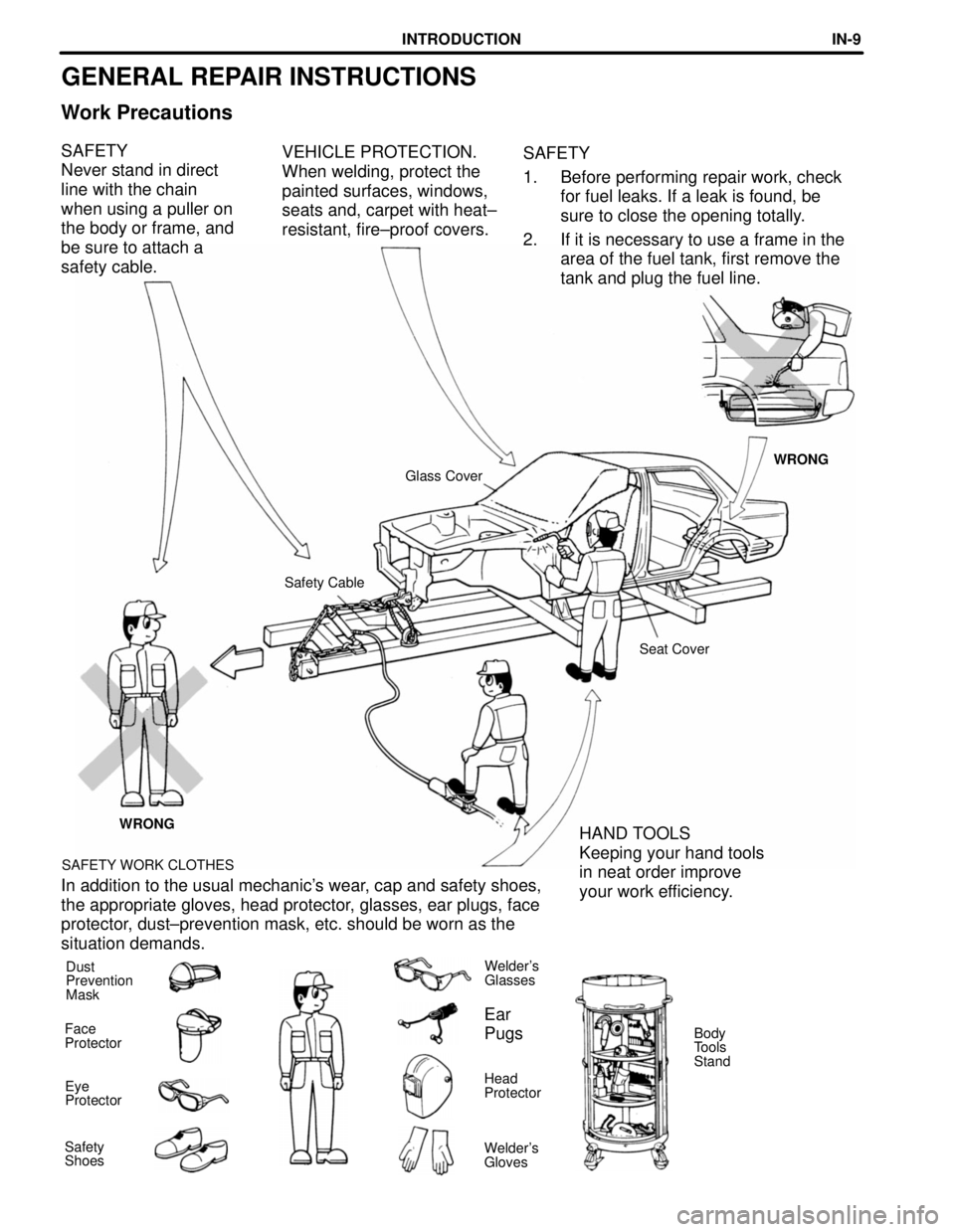Page 521 of 4770

42ENGINEÐ5S±FE ENGINE
5. Main Components of Engine Control System
The following table compares the main components of the new 5S±FE engine, and previous 5S±FE engine.
Model
NewPreviousComponentNewPrevious
Manifold Absolute Pressure SensorSemiconductoru
Throttle Position SensorLinear Typeu
Crankshaft Position SensorPick±Up Coil Type, 1u
Camshaft Position SensorPick±Up Coil Type, 1Ð
DistributorCamshaft PositionPick Up Coil Type 1DistributorSensorÐPick±Up Coil Type, 1
Knock SensorBuilt±In Piezoelectric
Element Type 1u
Oxygen Sensor
Heated Oxygen Sensor
(Bank 1, Sensor 1)*
1
(Bank 1, Sensor 2)
Air Fuel Ratio Sensor*
2
Oxygen Sensor
(Bank 1, Sensor 1)
(Bank 1, Sensor 2)
Injector2±Hole Typeu
IAC ValveRotary Solenoid Typeu
*1: Except for California Specification Models.
*
2: Only for California Specification Models.
Camshaft Position Sensor
The camshaft position sensor is mounted onto the
cylinder head. Using the protusion that is provided
on the timing pulley, the sensor generates 1 signal
for every revolution. This signal is then sent to the
ECM as a cranskshaft angle system.
Page 523 of 4770

44ENGINEÐ1MZ±FE ENGINE
1MZ±FE ENGINE
� DESCRIPTION
The 1MZ±FE engine has achieved a reduction in exhaust emissions through the adoption of the fuel returnless system
and the changes made onto the EGR control system.
� ENGINE SPECIFICATIONS AND PERFORMANCE CURVE
1MZ±FE EngineNewPreviousItemNewPrevious
No. of Cyls. & Arrangement6±Cylinder, V Typeu
Valve Mechanisms24±Valve DOHC,
Belt & Gear Driveu
Combustion ChamberPentroof Typeu
ManifoldsCross±Flowu
Fuel SystemsSFIu
Displacement cm3(cu. in.)2995 (182.7)u
Bore x Stroke mm (in.)87.5 x 83.0 (3.44 x 3.27)u
Compression Ratio10.5 : 1u
Max. Output {SAE_NET]145 kW @ 5200 rpm
(194 HP @ 5200 rpm)140 kW @ 5200 rpm
(188 HP @ 5200 rpm)
Max. Output {SAE_NET]283 N.m @ 4400 rpm
(209 ft
.lbf @ 4400 rpm)
275 N.m @ 4400 rpm
(203 ft
.lbf @ 4400 rpm)
IntakeOpen4o BTDCu
Valve Timing
IntakeClose44o ABDCuValve Timing
ExhaustOpen46oBBDCuExhaustClose2o
ATDCu
Fuel Octane Number RON91 OR Higheru
Oil GradeAPI SH EC±II, ILDAC or Betteru
Premium unleaded gasoline (96RON) is used for the above specifications.
Page 525 of 4770

46ENGINEÐ1MZ±FE ENGINE
� MAJOR DIFFERNCES
Major differences between the new 1MZ±FE engne and previous engine are listed below.
Item
Outline
Cooling SystemAn aluminum radiator core is used for weight reduction.
Intake and Exhaust System
Through the optimized allocation of the exhaust pipe supports, the number
number of supports has been reduced from 5 to 4, thus reducing the noise
and vibration which are transmitted to the vehicle body.
Fuel SystemA fuel returnless system has been adopted to prevent the internal temperature
of the fuel tank from rising, and to reduce evaporative emissions.
Engine MountingThe characteristics of the engine mounts, torque rod, and absorber have been
optimized to reduce noise and vibration.
Engine Control System
�A communication circuit has been provided between the ECM and the
ABS & TRAC ECU in conjunction with the adoption of the TRAC
(Traction Control) system.*
�The fuel pressure control has been discontinued in conjunction with the
adoption of the fuel returnless system.
�Instead of using the IDL signal input from the throttle position sensor,
the ECM now uses the VTA signal to detect the completely closed state of
the throttle valve.
�A new EGR system which uses a EGR valve position sensor is used.
�A communication method of the ECM and the hand±held tester has been
changed from the SAEJ1962 to the ISO 9141±2.
*: Applicable only to Vehicle Equipped with the TRAC System.
Page 527 of 4770

48ENGINEÐ1MZ±FE ENGINE
� ENGINE CONTROL SYSTEM
1. General
The engine control system of the new 1MZ±FE engine is basically the same in construction and operation as that of
the previous 1MZ±FE engine. However, the fuel pressure control has been discontinued and the EGR control system
has been changed.
The engine control system of the new 1MZ±FE engine and previous 1MZ±FE engine are compared below.
System
OutlineNewPrevious
SFI
(SequentialA L±type SFI system directly detects intake air mass with
a hot wire type mass air flow meter.��(q
Multiport Fuel
Injection)The fuel injection system is a sequential multiport fuel
injection system.��
ESA
Ignition Timing is determined by the ECM based on
signals from various sensors. The ECM corrects ignition
timing in response to engine knocking.
��
(Electronic Spark2 knock sensors are used to improve knock detection.��(p
Advance)In vehicles equipped with automatic transaxle, torque
control correction during gear shifting has been used to
minimize the shift shock.
��
IACA rotary solenoid type IAC valve controls the fast idle��(Idle Air Control)
A rotary solenoid type IAC valve controls the fast idle
and idle speeds.��
ACIS
(Acoustic Control
The intake air passages are switched according to the en-
gine speed and throttle valve angle to increase perfor��(Acoustic Control
Induction System)
gine speed and throttle valve angle to increase perfor-
mance in all speed ranges.��
Fuel Pressure
ControlIn hot engine conditions, the fuel pressure is increased to
improve restartability.��
Oxygen Sensor
Heater ControlMaintains the temperature of the oxygen sensor at an
approppiate level to increase accuracy of detection of
the oxygen concentration in the exhaust gas.
��
EGR Cut±Off
ControlCuts off EGR according to the engine condition to
maintain drivability of the vehicle and durability of
EGR components.
�
EGR Control
Uses the duty control type VSV and EGR valve position
sensor, controlling the EGR volumne in accordance with
engine conditions.
�Ð
Evaporative
Emission ControlThe ECM controls the purge flow of evaporative emis-
sions (HC) in the charcoal canister in accordance with
engine conditions.
��
Diagnosis
When the ECM detects a malfunction, the ECM diagnoses
and memorizes the failed section.��
DiagnosisThe diagnosis system includes a function that detects a
malfunction in the evaporative control system.�Ð
Fail SafeWhen the ECM detects a malfunction, the ECM stops
or controls the engine according to the data already stored
in memory
��
Page 606 of 4770

GENERAL REPAIR INSTRUCTIONS
Work Precautions
SAFETY
Never stand in direct
line with the chain
when using a puller on
the body or frame, and
be sure to attach a
safety cable.SAFETY
1. Before performing repair work, check
for fuel leaks. If a leak is found, be
sure to close the opening totally.
2. If it is necessary to use a frame in the
area of the fuel tank, first remove the
tank and plug the fuel line. VEHICLE PROTECTION.
When welding, protect the
painted surfaces, windows,
seats and, carpet with heat±
resistant, fire±proof covers.
WRONG
Glass Cover
Safety Cable
Seat Cover
WRONG
SAFETY WORK CLOTHES
HAND TOOLS
Keeping your hand tools
in neat order improve
your work efficiency. In addition to the usual mechanic's wear, cap and safety shoes,
the appropriate gloves, head protector, glasses, ear plugs, face
protector, dust±prevention mask, etc. should be worn as the
situation demands.
Dust
Prevention
MaskWelder's
Glasses
Ear
Pugs
Body
Tools
Stand Face
Protector
Head
Protector Eye
Protector
Safety
ShoesWelder's
Gloves
INTRODUCTIONIN-9
Page 711 of 4770

CAMRY ± OUTLINE OF NEW FEATURES
CAMRY
2
OUTLINE OF NEW FEATURES
The Camry is a high-quality family sedan with advanced technology and sporty performance. The following
changes are made for the 1998 model year.
1. Model Line-Up
�The SXV20L-AEPNKK and MCV20L-A (C) EPGKK models have been added.
�The MCV20L-CEPNKK model has been discontinued.
2. Interior Equipment
An extensible assist grip has been newly provided for the front passenger.
3. 5S-FE Engine
ORVR (On-Board Refueling Vapor Recovery) System has been adopted.
4. 1MZ-FE Engine
The 1MZ-FE engine with automatic transaxle on the California specification model uses the air-fuel ratio
sensor and the WU-TWC (Warm Up-Three-Way Catalytic Converters) to reduce exhaust emissions.
5. Body
�The cross section shape of the outside windshield moulding has been changed to reduce the wind noise.
�The front door window glass has been increased in thickness to reduce the amount of noise transmitted
from the outside of the vehicle.
�Front seat belt with pretensioner and force limiter has been adopted.
6. Engine Immobiliser System
An engine immobiliser system has been newly provided to help improve the vehicle's theft prevention perfor-
mance.
7. Theft Deterrent System
�The starter cutoff function has been discontinued along with the adoption of the engine immobiliser sys-
tem.
�The illumination pattern of the indicator light which indicates the condition of the system has been
changed.
Page 716 of 4770

CAMRY ± NEW FEATURES7
�1MZ-FE ENGINE
1. Description
On the California specification automatic transaxle model, the 1MZ-FE engine has adopted the air-fuel ratio
sensor and the WU-TWC (Warm Up-Three-Way Catalytic Converter) to reduce exhaust emissions.
2. Engine Specifications
1MZ-FE Engine
Item'98 Model'97 Model
No. of Cyls. & Arrangement6-Cylinder, V Type�
Valve Mechanism24-Valve, DOHC,
Belt & Gear Drive�
Combustion ChamberPentroof Type�
ManifoldsCross-Flow�
Fuel SystemSFI�
Displacement cm3 (cu. in.)2995 (182.7)�
Bore x Stroke mm (in.)87.5 x 83.0 (3.44 x 3.27)�
Compression Ratio10.5 : 1�
Max. Output [SAE-NET]
145 kW@5200 rpm
(194HP@5200 rpm),
143 kW@5200 rpm
(192 HP@5200 rpm)*
145 kW@5200 rpm
(194HP@5200 rpm)
Max. Torque [SAE-NET]
283 N.m@4400 rpm
(209 ft
.lbf@4400 rpm),
281 N
.m@4400 rpm
(207 ft
.lbf@4400 rpm)*
283 N.m@4400 rpm
(209 ft
.lbf@4400 rpm)
IntakeOpen4� BTDC�
Valve
IntakeClose44� ABDC�Valve
Timing
ExhaustOpen46� BBDC�g
ExhaustClose2� AT D C�
Fuel Octane Number RON91 or Higher�
Oil GradeAPI SH EC-II,
SJ EC or ILSACAPI SH EC II or ILSAC
Premium unleaded gasoline (96RON) is used for the above specifications.
*: California Specification Automatic Transaxle Model.
Page 851 of 4770

'99camry U
85
Part 1
OPERATION OF
INSTRUMENTS AND
CONTROLSÐ
Chapter 1±5
Gauges, Meters and
Service reminder
indicators
�Fuel gauge
�Engine coolant temperature
gauge
�Tachometer
�Odometer and two trip meters
�Service reminder indicators and
warning buzzers
Fuel gauge
Low fuel level
warning light
The gauge works when the ignition
switch is on and indicates the approxi-
mate quantity of fuel remaining in the
tank.
Nearly fullÐNeedle at ºFº
Nearly emptyÐNeedle at ºEº
It is a good idea to keep the tank over
1/4 full.
This fuel gauge has a non±return type
needle which remains at the last indicated
position when the ignition switch is turned
off.
If the fuel level approaches ºEº or the low
fuel level warning light comes on, fill the
fuel tank as soon as possible.On inclines or curves, due to the move-
ment of fuel in the tank, the fuel gauge
needle may fluctuate or the low fuel level
warning light may come on earlier than
usual.
If the fuel tank is completely empty, the
malfunction indicator lamp comes on. Fill
the fuel tank immediately.
The indicator lamp goes off after driving
several times. If the indicator lamp does
not go off, contact your Toyota dealer as
soon as possible.